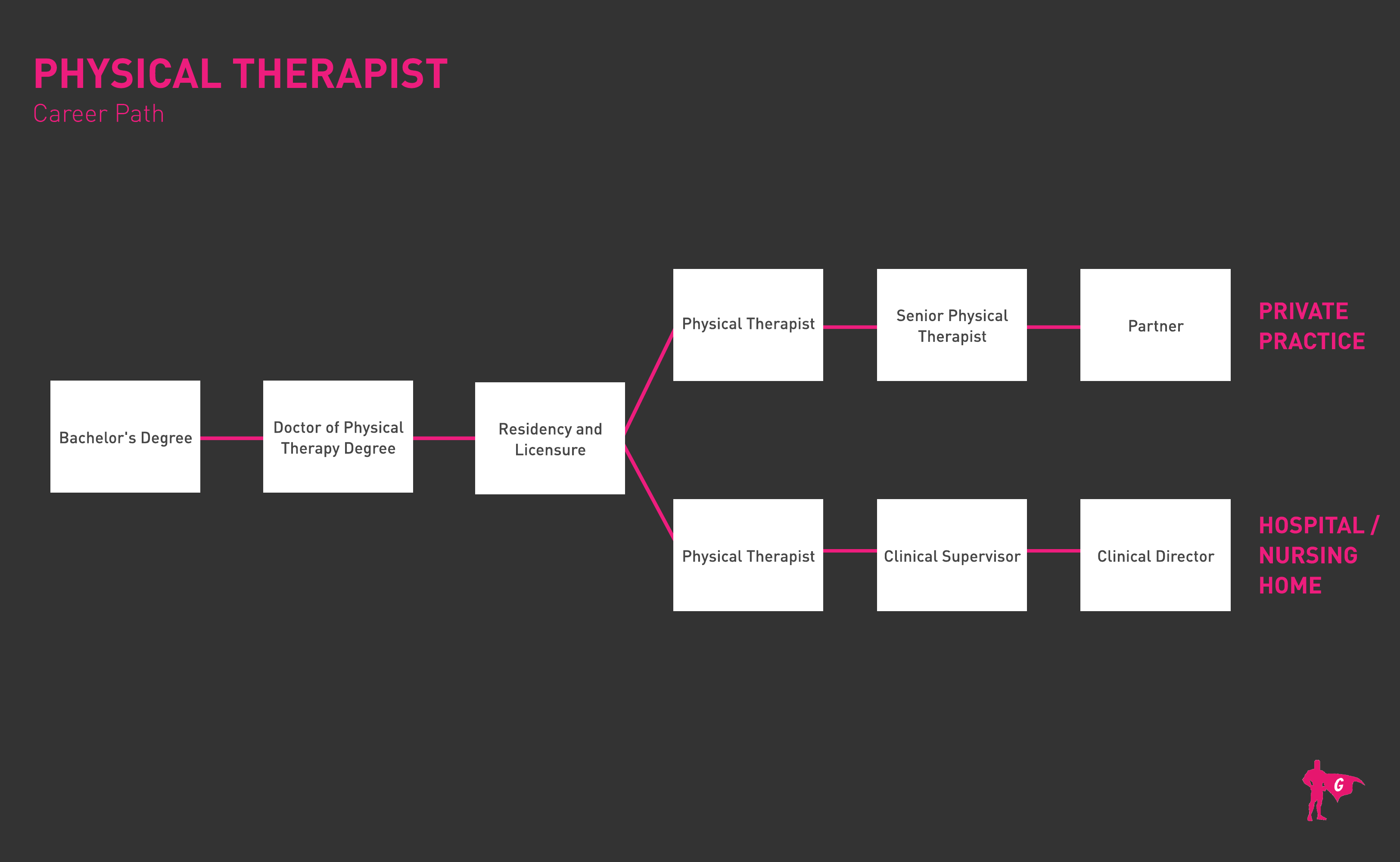Spotlights
Acute Care PT (Acute Care Physical Therapist), Doctor of Physical Therapy (DPT), Home Care Physical Therapist (Home Care PT), Inpatient Physical Therapist (Inpatient PT), Outpatient Physical Therapist (Outpatient PT), Pediatric Physical Therapist (Pediatric PT), Registered Physical Therapist (RPT), Therapist
Physical therapists help injured or ill people improve their movement and manage their pain.
- Help people recover from injuries
- See progress through treatment
- Working with both body and mind
- Connecting with people daily
- Good salary
"Continued learning of my field of interest (human anatomy and function), and in depth connection with individuals needing help to regain function of their bodies" Tommy Wong, Physical Therapist and Naval Officer, US Navy
They help injured or ill people improve their movement and manage their pain. These therapists are often an important part of rehabilitation, treatment, and prevention of patients with chronic conditions, illnesses, or injuries.
Physical therapists typically do the following:
- Review patients’ medical history and any referrals or notes from doctors, surgeons, or other healthcare workers
- Diagnose patients’ functions and movements by observing them stand or walk and by listening to their concerns, among other methods
- Develop individualized plans of care for patients, outlining the patients’ goals and the expected outcomes of the plans
- Use exercises, stretching maneuvers, hands-on therapy, and equipment to ease patients’ pain, help them increase their mobility, prevent further pain or injury, and facilitate health and wellness
- Evaluate and record a patient’s progress, modifying a plan of care and trying new treatments as needed
- Educate patients and their families about what to expect from the recovery process and how best to cope with challenges throughout the process
- Physical therapists provide care to people of all ages who have functional problems resulting from back and neck injuries; sprains, strains, and fractures; arthritis; amputations; neurological disorders, such as stroke or cerebral palsy; injuries related to work and sports; and other conditions.
The work of physical therapists varies by type of patient. For example, a patient working to recover mobility lost after a stroke needs different care from a patient who is recovering from a sports injury. Some physical therapists specialize in one type of care, such as orthopedics or geriatrics. Many physical therapists also help patients to maintain or improve mobility by developing fitness and wellness programs that encourage healthier and more active lifestyles.
Physical therapists work as part of a healthcare team, overseeing the work of physical therapist assistants and aides and consulting with physicians and surgeons and other specialists.
"I see patients everyday for their injuries and pain. I take anywhere from 30-90 minutes with each person, and sometimes I am juggling multiple people simultaneously. I coordinate with colleagues so everyone is taken care of, and I take care of other non-clinical tasks that involve smooth operation of the clinic, such as reviewing the performance of other staff and attending trainings." Tommy Wong, Physical Therapist and Naval Officer, US Navy
Click here for a physical therapist’s day in the life.
- Compassion
- Detail oriented
- Dexterity - use hands to provide manual therapy and therapeutic exercise
- Interpersonal skills
- Physical stamina
- Offices of physical, occupational and speech therapists, and audiologists
- Hospitals
- Home healthcare services
- Nursing and residential care facilities
- Self-employed workers
- On feet often to set up equipment and help treat patients
- Must lift and move patients
- May work weekends and nights
Demand for physical therapy will come in part from the large number of aging baby boomers, who are staying more active later in life than their counterparts of previous generations. Older people are more likely to experience heart attacks, strokes, and mobility-related injuries that require physical therapy for rehabilitation.
In addition, a number of chronic conditions, such as diabetes and obesity, have become more prevalent in recent years. More physical therapists will be needed to help these patients maintain their mobility and manage the effects of chronic conditions.
Advances in medical technology have increased the use of outpatient surgery to treat a variety of injuries and illnesses. Medical and technological developments also are expected to permit a greater percentage of trauma victims and newborns with birth defects to survive, creating additional demand for rehabilitative care. Physical therapists will continue to play an important role in helping these patients recover more quickly from surgery.
- Enjoy helping people
- Into science and biology
- Played sports and was active
- Physical Therapists are doctors who hold a Doctor of Physical Therapy (DPT) degree
- Some PTs start out as assistants with an Associate of Applied Science in Physical Therapist Assistant
- Most DPT students complete a bachelor’s such as a Bachelor of Health Sciences or Bachelor of Exercise and Sports Science, followed by a Master’s in Occupational Therapy, Master’s in Therapeutic Recreation, or Master’s in Rehabilitation Science
- Common bachelor-level courses include anatomy, physiology, biology, chemistry, and physics Advanced courses may include biomechanics, neuroscience, and pharmacology
- DPT program applicants apply through the Physical Therapist Centralized Application Service. It can take up to 5 weeks for applications to be reviewed
- Programs should be accredited by the Commission on Accreditation in Physical Therapy Education (CAPTE)
- Some programs feature a BS/DPT “bridge” option which can save a year or more!
- DPT graduates complete a supervised residency of one year. They have the option to specialize through fellowships
- The American Board of Physical Therapy Residency and Fellowship Education lists applicable residency and fellowship programs
- Accredited residencies include:
- Acute Care
- Cardiovascular & Pulmonary
- Clinical Electrophysiology
- Faculty residency (nonclinical)
- Geriatrics
- Neurology
- Oncology
- Orthopaedics
- Pediatrics
- Sports
- Women's Health
- Wound Management
- Accredited fellowships include:
- Critical Care
- Hand Therapy
- Higher Education Leadership (nonclinical)
- Movement System
- Neonatology
- Orthopaedic Manual Physical Therapy
- Performing Arts
- Spine
- Sports
- Upper Extremity Athlete
- The American Board of Physical Therapy Specialties offers certification in: Cardiovascular & Pulmonary, Clinical Electrophysiology, Geriatrics, Neurology, Oncology, Orthopedics, Pediatrics, Sports, Women's Health, Wound Management
- Other organizations which offer certifications include:
- American Board of Wound Management
- American Kinesiotherapy Association
- Biofeedback Certification International Alliance
- Hand Therapy Certification Commission
- Medical Exercise Training Institute
- National Strength and Conditioning Association
- All states require Physical Therapists to be licensed, which involves passing the National Physical Therapy Examination and, in many cases, a background check
- To maintain licensure, PTs must complete continuing education to stay up-to-date
- Take college prep classes in high school, including biology, chemistry, math, English, and communications. Study hard to earn good grades so you can get accepted into a suitable college program
- Shadow or interview a working PT
- Volunteer or intern in healthcare settings where you can learn about patient care
- Consider BS/DPT bridge programs if you are sure you want to be a PT!
- Read or watch interviews with PTs and learn about the various areas of specialization
- Learn about the specific licensure requirements for the state you plan to work in
- Stay out of trouble so you can pass the background check!
"Passing rate of licensing board, curriculum solely directed at PTs or mixed with other programs (MDs, dentists, etc), quality of internship programs...:" Tommy Wong, Physical Therapist and Naval Officer, US Navy

- Build strong connections while doing clinical residencies or fellowships. Keep an eye open for future job opportunities!
- Look for jobs on Indeed, Simply Hired, Glassdoor, or other popular job portals
- Create a professional LinkedIn account and list all of your experiences
- Consider earning a certification in an underserved area of specialization
- Go where the most PT jobs are! The states with the highest concentration of jobs for Physical Therapists are Maine, Montana, Alaska, Vermont, and Wyoming. The highest employment levels are in California, New York, Texas, Florida, and Pennsylvania
- Check out Physical Therapists resume templates for ideas on formatting and phrasing
- Review sample Physical Therapists interview questions
- Make sure to conduct a few practice mock interviews and remember to dress for interview success!
Manager
- A leader with an entrepreneurial spirit, and years of experience treating patients.
- Responsibilities include: Supervise, train, and hire staff; oversee day-to-day operations; clinical activities, communication, budgeting, and resource allocation; and ensure clinic compliance.
Director
- Responsibilities include HR, operational, and financial duties.
Owner
- Be your own boss and run your own private practice.
Professor at DPT Program
Websites
- American Board of Physical Therapy Residency and Fellowship Education
- American Board of Physical Therapy Specialties
- American Board of Wound Management
- American Kinesiotherapy Association
- American Physical Therapy Association
- Biofeedback Certification International Alliance
- Commission on Accreditation in Physical Therapy Education
- Federation of State Boards of Physical Therapy
- Hand Therapy Certification Commission
- Medical Exercise Training Institute
- National Physical Therapy Examination
- National Strength and Conditioning Association
- Physical Therapist Centralized Application Service
Books
- Acute Care Physical Therapy: A Clinician's Guide, by Daniel J. Malone and Kathy Lee Bishop
- Introduction to Physical Therapy, by Michael A. Pagliarulo PT EdD
- National Physical Therapy Examination Review and Study Guide, 2022, by & Sutlive O'Sullivan, Siegelman, Shaffer
"PT is a new and growing field, and the science is always improving and changing. PTs have failed for not staying innovative. The information is out there, and if one is truly passionate about the field, then success will come from the pursuit of learning more." Tommy Wong, Physical Therapist and Naval Officer, US Navy
Newsfeed

Featured Jobs

Online Courses and Tools








